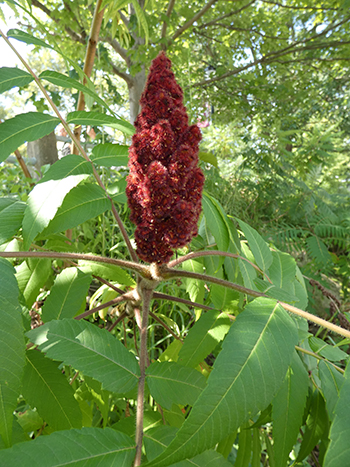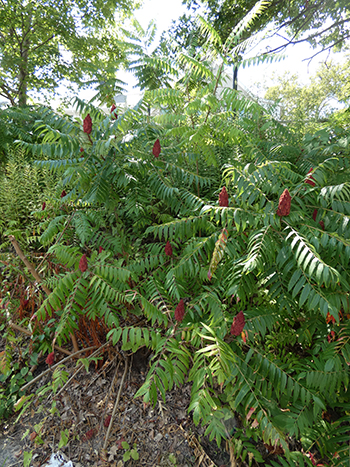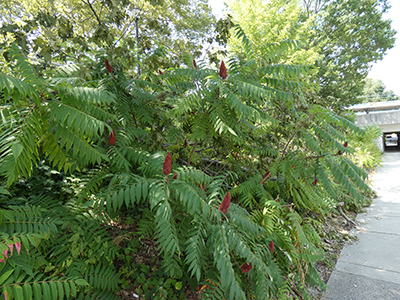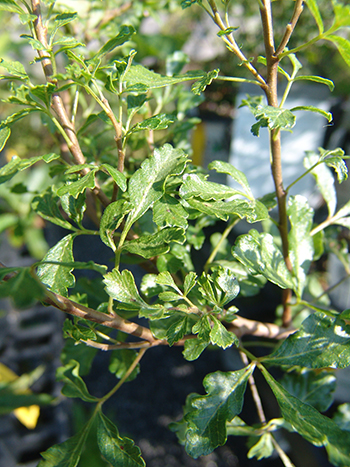
Rhus typhina (staghorn sumac)
Guest Author: Ben Hitz, 2019 summer intern
Rhus typhina (staghorn sumac)

By late July, the small flowers have transitioned to eye-catching bright red berries covered in velvety hairs resembling those on a stag’s horn – hence the common name. photo credit: B. Hitz
During the hottest part of midsummer, most native trees and shrubs are not looking their showiest. With spring flowering well past, and fall color still a few months away, many species spend the dog days storing energy from the ample sunlight to produce fruit. An exception is Rhus typhina, commonly called staghorn sumac.

R. typhina is the largest of North American sumacs, reaching up to 25’ tall with a spreading habit. photo credit: B. Hitz
In the Anacardiaceae (sumac) family, R. typhina produces tiny, greenish-yellow flowers in cone shaped panicles from late May to mid June. By late July, these small flowers have transitioned to eye-catching bright red berries covered in velvety hairs resembling those on a stag’s horn – hence the common name. As the season transitions to fall, its compound, serrated leaves turn a brilliant mix of yellow, orange, and red. The fruit continues to darken to blood red through fall and winter and is a valuable food source for many overwintering songbirds.
R. typhina is the largest of North American sumacs, reaching up to 25’ tall with a spreading habit. It spreads aggressively through underground rhizomes and needs a large, open space where it can form colonies. It does well in a broad range of soil types as long as it is in a well drained area. R. typhina is a pioneer plant that appears along roadways, vacant city lots, and other disturbed areas. Because of its similar leaf pattern and similar eagerness to grow in difficult conditions, it is often confused with the non-native and invasive Ailanthus altissima (tree of heaven).

R. typhina is a great addition to a native woodland restoration project because of its ability to attract wildlife during multiple seasons and its potential to outcompete invasive species. photo credit: B. Hitz
This vigorous sumac is best used in informal gardens and naturalized areas. It makes a great roadside screen because of its tolerance of salt spray and its willingness to grow in dry, disturbed areas. The erosion controlling potential is demonstrated on the steep embankment along Chester Road in front of The Inn.
Moreover, R. typhina is a great addition to a native woodland restoration project because of its ability to attract wildlife during multiple seasons and its potential to outcompete invasive species.

LacetteTM is a compact growing selection with a lacy appearance. photo credit: R. Robert
At the 2019 Scott Arboretum Selections: Fall Sale on Saturday, September 14, we will have Rhus aromatic ‘Fine Textured Compact Select A’, LacetteTM fragant sumac. Like R. typhina, the fragant sumac is known for its toughness in the landscape as well great fall color. LacetteTM is a compact growing selection with a lacy appearance. A great native selection for woodland restoration or erosion control.
Try these sun loving plants in your garden.





No Comments